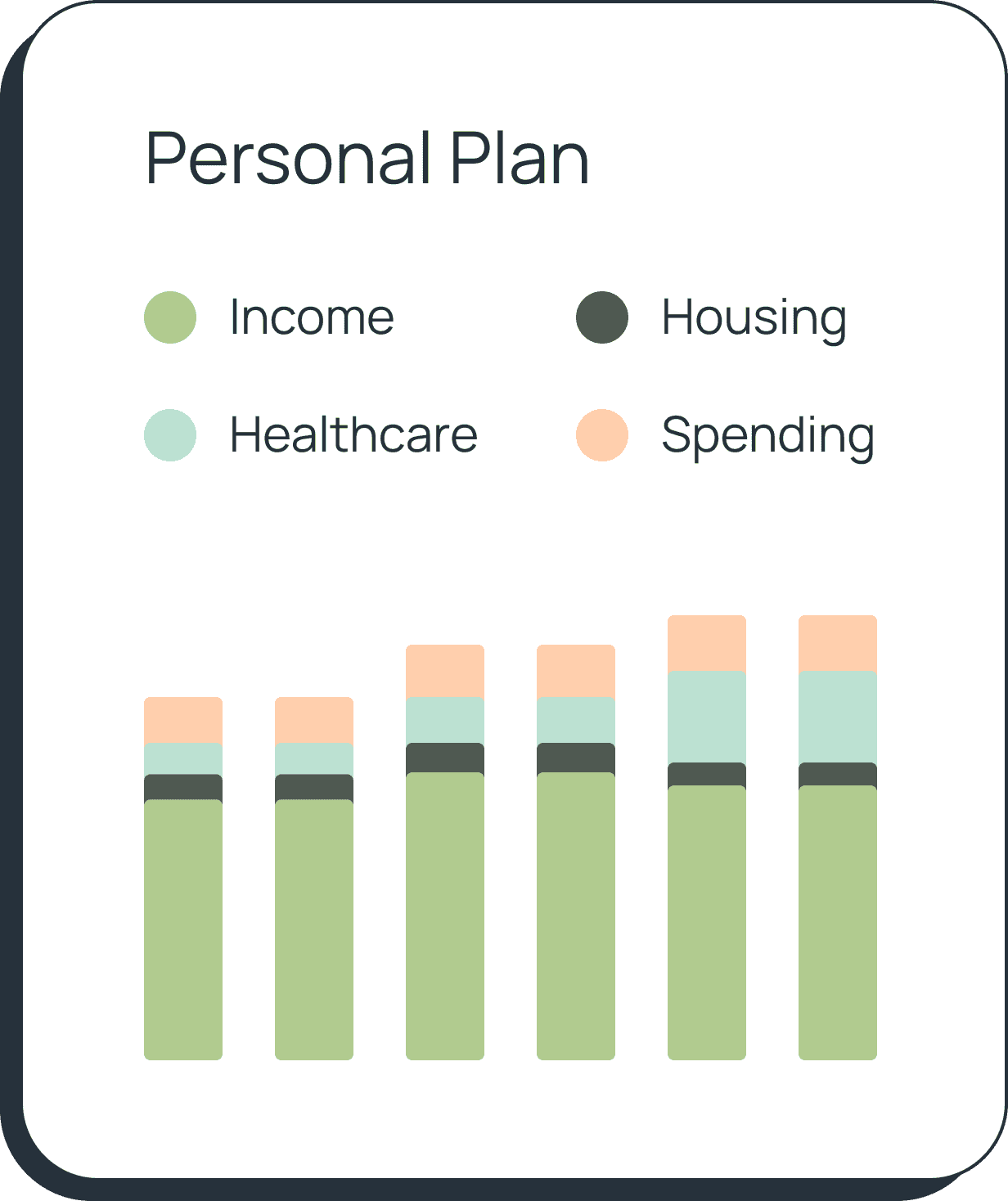Retirement Accounts
A Roth IRA and a 401(k) both provide you with tax-advantaged growth on your contributions.

R. Tyler End, CFP®
•
Published December 5th, 2024
•
Updated January 18th, 2025
Table of Contents
Key Takeaways
401(k) and Roth IRA accounts tend to be the go-to retirement savings options.
With a 401(k), you can contribute more and there are no income limits, but you’ll have to pay taxes on the withdrawals when you retire.
A Roth IRA has income limits and allows you to contribute up to $7,000 per year, or $8,000 if you're age 50 or older.
If your employer offers a 401(k) retirement savings account, taking advantage of it is usually wise. You can have funds taken out of your account, pretax, reducing your taxable income each year. Some employers will even match your contributions up to a certain limit.
But once you've maxed out your 401(k), an individual retirement account (IRA) can be an excellent way to put additional money aside for retirement. When comparing a Roth IRA vs 401(k), the most significant variation is typically the way they're taxed. There are a few other notable differences, though.
401(k) vs. Roth IRA
Saving for retirement is essential—and the earlier you start, the more time your money has to grow through the power of compounding. Two of the most common tools for retirement savings are Roth IRAs and 401(k)s. While they serve the same purpose, they have key differences in how contributions and withdrawals are taxed.
Both Roth IRAs and 401(k)s offer valuable tax advantages, but the timing of those tax benefits is what sets them apart.
With a 401(k), contributions are made pre-tax—your employer deducts the funds from your paycheck before income taxes are applied. This reduces your taxable income today, allowing you to potentially lower your annual tax bill during your working years. However, you’ll pay income taxes on your withdrawals in retirement.
A Roth IRA, by contrast, is funded with after-tax dollars—meaning you contribute money that’s already been taxed. While you don’t get an upfront tax break, your withdrawals in retirement are completely tax-free, including any investment gains. Roth IRAs are opened individually through a broker or financial institution and are not tied to your employer.
Questions about your retirement accounts? We're here to help.
Schedule your FREE Retirable consultation today.What is a 401(k)?
A 401(k) is an employer-sponsored retirement savings account. These accounts let employees opt-in to have money taken out of each paycheck to fund retirement. A 401(k) is pretax versus a Roth 401(k), in which you put the money in after paying taxes.
A 401(k) and Roth IRA are designed to fund retirement. But with a 401(k), you'll pay taxes when you take the funds out. However, one of the most significant benefits of a 401(k) is the higher contribution limit. For 2025, you can contribute up to $23,500 to a 401(k) (or $31,000 if you're age 50 or older). With a Roth IRA, the contribution limit remains $7,000 (or $8,000 if you're 50 or older).
What is a Roth IRA?
The biggest differences between a Roth IRA and a 401(k) are how you access them—and how they’re taxed. A 401(k) is typically offered through your employer, while a Roth IRA is something you open on your own—usually through an online broker or financial institution.
With a Roth IRA, you contribute money that’s already been taxed. That means you won’t get a tax break now, but your withdrawals in retirement—including any investment gains—are completely tax-free.
However, Roth IRAs come with income limits. If you earn above a certain threshold, your ability to contribute may be reduced—or phased out entirely. For this reason, Roth IRAs are often a better fit for low- to moderate-income earners. High earners may not qualify at all, and even if they do, the benefit of paying taxes now might not make sense if their tax rate drops in retirement.
If you're unsure which option makes more sense for your financial situation, talking with a financial advisor can help you weigh the long-term pros and cons.
Key Differences
There are several key differences between Roth and 401(k). But in addition to when you pay taxes, your income will play a key role in which option is better for you.
For high earners, a 401(k) is often the more accessible choice. That’s because Roth IRAs have income limits, while 401(k) plans do not. In 2025, if you earn $165,000 or more as a single filer—or $246,000 or more as a married couple filing jointly—you’re not eligible to contribute to a Roth IRA.
Even if your income falls just below those thresholds, you may still be affected. In 2025, the Roth IRA contribution phaseout range is:
- $150,000 to $165,000 for single filers
- $236,000 to $246,000 for joint filers
If your modified adjusted gross income (MAGI) falls within those ranges, your allowable contribution will be reduced. For many people in these income brackets, contributing to a traditional or Roth 401(k)—which has no income restrictions—may be the easier path to maximizing retirement savings.
| Key feature | 401(k) | Roth IRA |
|---|---|---|
| Taxes on contributions | Funds are deposited pre-tax | Funds are deposited after tax |
| Taxes on distributions | Withdrawn funds are taxed as ordinary income | Qualified withdrawals are tax-free |
| Required minimum distributions (RMDs) | Must begin taking funds out by age 73 (if you turn 72 after Jan 1, 2023) | No required minimum distributions |
| Contribution limits (for 2024) | $23,000 (or $30,500 for those age 50 and over) | $7,000 (or $8,000 for those age 50 and over) |
| Income limits (for 2024) | No income limits | $153,000 for single filers and $228,000 for joint filers |
| Contribution limits (for 2025) | $23,500 (or $31,000 for those age 50 and over) | $7,000 (or $8,000 for those age 50 and over) |
| Income limits (for 2025) | No income limits | $165,000 for single filers and $246,000 for joint filers |
Final Thoughts
Choosing between a traditional 401(k) and a Roth IRA isn’t always straightforward—it depends on your income, tax situation, and long-term retirement goals. A 401(k) may offer higher contribution limits and employer matching, while a Roth IRA provides the potential for tax-free growth and more withdrawal flexibility.
We recommend consulting a Certified Financial Planner® who can look at your income, employer-provided retirement savings options, and retirement goals and help you decide which option is best for you.
Frequently asked questions
What is the main difference between a 401(k) and a Roth IRA?
The primary difference lies in tax treatment. Contributions to a traditional 401(k) are made with pre-tax dollars and are taxed upon withdrawal. In contrast, Roth IRA contributions are made with after-tax dollars, but withdrawals during retirement are tax-free.
Can I contribute to both a 401(k) and a Roth IRA?
Yes, you can contribute to both a 401(k) and a Roth IRA in the same year, provided you meet the income eligibility requirements for the Roth IRA.
What are the contribution limits for a 401(k) and a Roth IRA in 2024?
Contribution limits can change from year to year due to inflation adjustments. Here’s a quick breakdown of the maximum you can contribute to each account in 2024 and 2025:
For 401(k) plans:
- 2024: $23,000 (plus $7,500 catch-up if age 50+)
- 2025: $23,500 (plus $7,500 catch-up if age 50+)
For Roth IRAs:
- 2024 & 2025: $7,000 (plus $1,000 catch-up if age 50+)
Are there income limits for contributing to a 401(k) and Roth IRA?
There are no income limits for contributing to a 401(k).
However, Roth IRA contributions are subject to income phaseouts:
- 2024: Phaseouts begin at $153,000 (single) and $228,000 (married filing jointly)
- 2025: Phaseouts begin at $150,000 (single) and $236,000 (married filing jointly)
If your income exceeds the upper limit, you cannot contribute directly to a Roth IRA.
How do withdrawals work for each plan?
401(k) withdrawals are taxed as ordinary income, and early withdrawals before age 59½ may incur a 10% penalty. Roth IRA contributions can be withdrawn tax- and penalty-free at any time. Earnings are tax-free if the account is at least five years old and you’re 59½ or older (or meet another qualifying condition).
What about employer matching contributions?
Many 401(k) plans offer employer matching, which can significantly boost your retirement savings. Roth IRAs, being individually managed and not employer-sponsored, do not offer matching contributions.
Which is better for tax savings?
It depends on your current and future tax bracket. If you expect to be in a higher tax bracket in retirement, a Roth IRA may save you more in the long run. If you expect your income (and tax rate) to be lower in retirement, a traditional 401(k) could offer more immediate tax benefits.
Can I roll over my 401(k) into a Roth IRA?
Yes, you can roll over funds from a 401(k) into a Roth IRA, but you must pay taxes on the rolled-over amount since Roth IRAs are funded with after-tax dollars.
Share this advice

Tyler is a Certified Financial Planner® and CEO & Co-Founder at Retirable, the retirement peace of mind platform. Tyler has nearly 15 years of experience at leading companies in the wealth management and insurance industries. Before Retirable, Tyler worked as Head of Operations Expansion at PolicyGenius, expanding the company’s reach into new products — turning PolicyGenius into an industry-leading disability and P&C insurance distributor. Before working at PolicyGenius, Tyler worked as Wealth Management Advisor at prominent financial services organizations.
As an advisor, Tyler played an integral role in helping clients define goals, achieve financial independence and retire with peace of mind. Through this work, Tyler has helped hundreds of thousands of people get the financial planning and insurance advice they need to succeed. Since founding Retirable, Tyler’s innovative approach to retirement planning has been featured in publications such as Forbes, Fortune, U.S. News & World Report, and more.
Understanding 401(k)s
401(k) Rules
Cashing Out your 401(k)
Understanding Roth 401(k)s
Roth IRA Basics
Share this advice

Tyler is a Certified Financial Planner® and CEO & Co-Founder at Retirable, the retirement peace of mind platform. Tyler has nearly 15 years of experience at leading companies in the wealth management and insurance industries. Before Retirable, Tyler worked as Head of Operations Expansion at PolicyGenius, expanding the company’s reach into new products — turning PolicyGenius into an industry-leading disability and P&C insurance distributor. Before working at PolicyGenius, Tyler worked as Wealth Management Advisor at prominent financial services organizations.
As an advisor, Tyler played an integral role in helping clients define goals, achieve financial independence and retire with peace of mind. Through this work, Tyler has helped hundreds of thousands of people get the financial planning and insurance advice they need to succeed. Since founding Retirable, Tyler’s innovative approach to retirement planning has been featured in publications such as Forbes, Fortune, U.S. News & World Report, and more.



